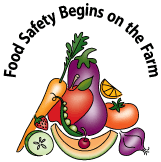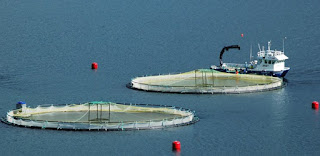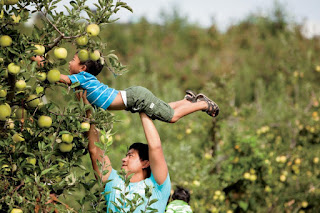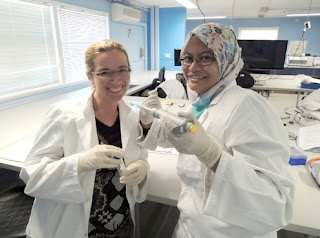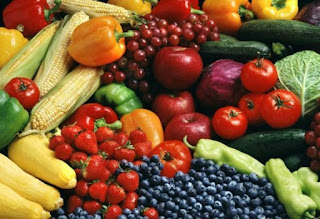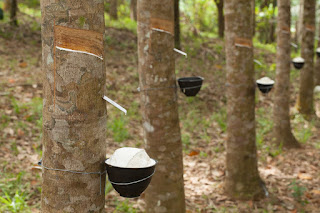PRT2008 (Group 6)
loveagriculture GROUP6-- NURSHAZANI FAMIRAH BINTI JOHARI (182833) -- NUR HIDAYAH BINTI HASSAN (184267) -- SYAFIQAH BINTI SAPUAN (183313)-- SITI ZAHARAH BINTI SALLEH (184893)-- ROHAYU BINTI ARIFIN (184263)-- ERMA BINTI ABDUL MANAN (184475)-
Wednesday 1 June 2016
Tuesday 31 May 2016
CHAPTER 8 : AGRICULTURE & MALAYSIAN ECONOMY
Agriculture remains an important sector of Malaysia's economy, contributing 12 percent to the national GDP and providing employment for 16 percent of the population. The British established large-scale plantations and introduced new commercial crops (rubber in 1876, palm oil in 1917, and cocoa in the 1950s).
As rice is a staple foodstuff in the everyday diet of Malaysians and is a symbol of traditional Malay culture, the production of rice, which stood at 1.94 million metric tons in 1998, plays an important part in the country's agriculture. However, the overall production of rice does not satisfy the country's needs, and Malaysia imports rice from neighboring Thailand and Vietnam.

CHAPTER 9: APPROACHES TO AGRICULTURAL DEVELOPMENT IN MALAYSIA
Approaches to agricultural development in Malaysia
1) Policies
How to enhance food security?
1) Policies
- National Agricultural Policy 1
- National Agricultural Policy 2
- National Agricultural Policy 3
- National Agrofood Policy
2) Good Agriculture Practices
3) Organic farming
4) New agricultural sectors:
Fisheries involving deep sea fishing activities have commenced,with new fishing harbours in
Penang and Sarawak opened.
Aquaculture activities in inland water bodies have increased with cultivation of commercial
species. Mariculture has also expanded in islands such as Langkawi. Recreational fisheries
and aquariums are new business ventures.
Tourism industry has been given a new lease of life in the form of agrotourism involving tours
to forests, nature reserves, farms and homestays.
How to enhance food security?
A) Enhance Domestic food production
Focusing production on major food products that are cost competitive such as fishery products, selected fruits, vegetables and livestock.
B) Strategic sourcing
Facilitating joint venture with low-cost countries, for example in the ASEAN Growth Areas and Mekong River Basin.
C) Improving marketing efficiency
Reducing market intermediaries with direct marketing and contract farming
d) Increasing Productivity
New products and future industries
The ETP Transformation Story
The Economic Transformation Programme (ETP) is a comprehensive effort that will transform Malaysia into a high-income nation by 2020.
- See more at: http://etp.pemandu.gov.my/#sthash.5R65EL2b.dpuf
Monday 30 May 2016
Our beloved lecturer "Dr Natrah Fatin Mohd Ikhsan"
Dr Natrah Fatin Mohd Ikhsan, one of the two recipients of the 2012-2013 Merdeka Award Grant for International Attachment, has completed a short programme at the Sydney Institute of Marine Science (SIMS) in Australia and is currently attached to the Scripps Institution of Oceanography in California, United States.
Congratulation DR ^_^. PERFORM DR .wow!!!! amazing DR.
Dr Natrah obtained her BSc (Hons) in Biology and MSc in Aquatic Biotechnology from University Putra Malaysia. In 2011, she received her PhD in Applied Biological Sciences from the Laboratory of Aquaculture and Artemia Reference Center, University of Ghent, Belgium.
She specialises in microbial ecology, particularly in understanding the interaction between bacteria and algae for aquaculture use. She is the author of various research articles in international peer-reviewed journals as well as several international and national conference proceedings.
She is also the project leader of several research grants from private and governmental bodies including the Yayasan Pak Rashid Grant, the MOSTI ScienceFund and the Knowledge Transfer Programme with the Aquaculture Industry. In addition, she is involved in international projects with the Japan Society for the Promotion of Science (JSPS), collaborating with different scientists from different research institutions.
Currently, Dr Natrah is attached to the Department of Aquaculture, Faculty of Agriculture and Laboratory of Marine Biotechnology, Institute of Bioscience, University Putra Malaysia. She is also the treasurer of the Malaysian Fisheries Society.
For her Merdeka Award Grant for International Attachment, Dr Natrah is researching on interaction between micro-organisms.
The attachment will allow her to build a sound fundamental research foundation that she believes is essential to producing strong applied research. Increased understanding of the latest modern molecular techniques and better data interpretation in microbial ecology gained from the institution will contribute to resolving current problems related to microbial ecology. The attachment will also allow her to exchange expertise and experiences with prominent microbial ecologists, and potentially bridge connections for future Asia Pacific collaborations.
Dr Natrah also hopes the knowledge shared will inspire and ignite a passion for science, especially amongst young Malaysians, and attract more Malaysians to be involved in agriculture.
We are very proud to be your student ^_^ ,thank you Dr . Good luck Dr.
Tuesday 17 May 2016
CHAPTER 7 . INNOVATION AND CHALLENGES IN MALAYSIAN AGRICULTURE
INNOVATION AND CHALLENGES IN MALAYSIAN
AGRICULTURE
Technological
Innovation from Research Institutes
GOVERNMENT BODIES
1. MARDI
--Malaysian Agricultural Research and Development Institute
--It is a is a government body in Malaysia under Ministry of Agriculture and Agro-Based Industry (MOA).
GOVERNMENT BODIES
1. MARDI
--Malaysian Agricultural Research and Development Institute
--It is a is a government body in Malaysia under Ministry of Agriculture and Agro-Based Industry (MOA).
2.Malaysian Palm Oil Board
--It is a government agency responsible for the promotion and development of the palm oil industry in Malaysia.
--It is one of agencies under Malaysia's Ministry of Plantation Industries and Commodities.
--It is a government agency responsible for the promotion and development of the palm oil industry in Malaysia.
--It is one of agencies under Malaysia's Ministry of Plantation Industries and Commodities.
3. MCB
--Malaysian Cocoa Board
--It is a federal statutory research and development agency under the Ministry of Plantation Industries and Comodities (previously called Ministry of Primary Industries Malaysia).
--Malaysian Cocoa Board
--It is a federal statutory research and development agency under the Ministry of Plantation Industries and Comodities (previously called Ministry of Primary Industries Malaysia).
4. MRB
--Malaysian Rubber Board
--It is the custodian of the rubber industry in Malaysia.
--Malaysian Rubber Board
--It is the custodian of the rubber industry in Malaysia.
UNIVERSITIES
1. Universiti Putra Malaysia (UPM)
2. Universiti Kebangsaan Malaysia (UKM)
3. Universiti Malaya (UM)
PRIVATE SECTORS
1. Sime Darby
2. IOI
3. FELDA ( Federal Land & Development Authority)
4. FELCRA (Federal Land Consolidation and Rehabilitation Authority)
Research and Innovation Technology
1. Oil Palm
--It is Malaysia's golden crop contributing about RM30 billion to its gross national product (GNP) annually.
--Improve the yield of oil palm to 35 tonnes fresh fruit bunches per hectare per year, using the Tenera hybrid bred from the crossing of Dura and Pisifera varieties in early years.
1. Universiti Putra Malaysia (UPM)
2. Universiti Kebangsaan Malaysia (UKM)
3. Universiti Malaya (UM)
PRIVATE SECTORS
1. Sime Darby
2. IOI
3. FELDA ( Federal Land & Development Authority)
4. FELCRA (Federal Land Consolidation and Rehabilitation Authority)
Research and Innovation Technology
1. Oil Palm
--It is Malaysia's golden crop contributing about RM30 billion to its gross national product (GNP) annually.
--Improve the yield of oil palm to 35 tonnes fresh fruit bunches per hectare per year, using the Tenera hybrid bred from the crossing of Dura and Pisifera varieties in early years.
ADVANTAGES OF AJIB
1.
increase plant
enzyme activities
2.
increase farmers'
income
3.
increase pollen
viability
4.
increase oil
extraction ration (O.E.R)
2. Rubber
- The Malaysian Rubber Board (MRB)
- developed high yield and disease
resistant clones producing >3,500kg rubber ha-1 yr1
·
new innovation in
rubber tapping
1. puncture tapping or microtapping
- increased
production of latex
-
produce yields with hormonal stimulation (Ethral) compare to conventional
excision tapping.
2. Latex-Timber Clone (LTC)
- different clones (eg: RRIM928, RRIM929)
- trunk harvested for timber
industry
- vitamin E has also been extracted
from the latex.
-current production is sustained at
750,000 million tonnes yr1.
3. Cocoa
- import from Indonesia to fulfill the
requirement of the many processing factories.
- 2002 - Addition of biotechnology division
of Malaysian Cocoa Board
- aim - to implement research and
development in cocoa biotechnology as well as to provide services to the
entire cocoa industry
- cocoa biotechnology research : a)
agrobiotechnology to improve productivity and production efficiency b)
biotechnology enhanced - quality of cocoa products with respect to safety
and health c) industrial and pharmaceutical biotechnology to obtain new
products such as useful bioactive compound, associated microbes in the
cocoa environment, cocoa waste and etc.
4. Paddy
- achieves ONLY 70 %
self-sufficient in rice.
- major production centres (rice bowls)
MADA (Kedah-Perlis), KADA (Kelantan), and Sawah Sempadan-Tanjung Karang
(Selangor).
- Government aims to raise the yield to 10
ton ha-1 with the use of new technology.
- popular varieties :MR220, MR219, MR211,
MR81.
- Malaysia will strive to achive 90%
self-sufficient leve (SSL) in the near future.
- Vita-grow - paddy fertilizer

a)
a foliar fertilizer developed by UPM that contains complete and balanced plant
nutrients that enhances growth of paddy, fruits, vegetable and etc.
b) specially formulated chemical fertilizer.
c) successful in doubling paddy yield and
producing better.
- Zappa - UPM product that enhances rapid germination and tillering.
--Zappa is another UPM product that
enhances rapid germination and tillering.
5) Livestock
- grow at the rate of 3.1% per annum from
RM 953million in 1995 to RM 1.1 billion in 2000.
- integration of livestock rearing in oil
palm plantations.
- reducing management cost.
- land development agencies - FELDA, RISDA,
FELCRA.
- Hybridization : new breed of beef cattle
named BRAHMAS, a cross-breed between imported Brahman and local
Kedah-Kelantan breed.
- more resistant to diseases.
6) Fisheries
- Aquaculture is cultivation of natural
produce of water such as fish, shellfish, algae and other aquatic
organisms.
- It also known as aquafarming, the term is
distinguished from fishing by the idea of active human effort.
- The government is encouraging
locals to adopt aquaculture by constructing ponds and raising fishes in
net cages in rivers, lakes and sea shores.
- A rapid detection kit has been developed
to detect white spot syndrome virus (WSSV) disease in prawns.
7)
- Research has been conducted to improve
commercial production of banana, pineapple, papaya, starfruits, mango,
durian, watermelon, jackfruits, rambutan, and ciku.
- Flowers such as orchids is a growing
industry.
- Mushroom which are strictly fungi but
considered as ‘vegetables’ is a growing industry in Malaysia.
8) Bioagents
- Innovations using biological
organisms van be found in the form of biofertillizers such as Rhizobium
and biocontrol agents.
- UPM has formulated naturally occurring
antagonistic fungi, effective against diseases of vegetables.
9) Precision
Agriculture
- This is a new innovation in agriculture.
It also known as ‘site specific management’.
- This approach has initially attracted the
interest of the plantation sector.
- It is being practised partly in oil
palm and paddy growing areas.
FUTURE CHALLENGERS IN
AGRICULTURE
There are several challenges now facing the agriculture industry:
1.
Labour
- There are dependence of foreign labour
with some estates employing 100% foreigners particularly those from
Indonesia and Philippines.
- Cost of
labour has been rising steadily.
- Local youths are
less interested in agriculture, preferring to work in factories and
offices.
2.
Price
- Increase
in the price of fertilizers, seeds, tools, and equipment has effeted the
cost of agriculture production.
- Market price is also
elastic and problematic at the times.
3.
Crop Choice
- Big
conglomerates are not interested in agriculture other than planting oil
palm and rubber.
4. Agricultural Technology
- The
benefit from prospecting and developing the potential and applications of
new and frontier technology are not yet to be realized.
a) The use of plant cell
and tissue culture techniques as well as genetic engineering to complement
conventional plant breeding in developing new crop varieties.
b) The use of
plant cell culture to enhance the development of new and innovative products
including metabolites.
c) The
application of embryo manipulation technology
d) The incorporation of
robotics and artificial intelligence as well as computer modelling, including
expert systems and computer simulated scenario analysis.
5. Resources
- Resources
have to be carefully managed in order that agriculture could be sustained.
- The main challenges in the
future is to enable continuous crop production with high yield per unit
areas.
- Land development will
slowly encroach into fragile soils, especially peat and steep lands.
- This result in soil
degradation.
- Water resources
management is also an important issues as only 21% of the country heavy
rainfall is being used currently.
https://www.facebook.com/667356516701737/videos/869693329801387/
Saturday 14 May 2016
CHAPTER 6 : SUSTAINABLE AGRICULTURE
DEFINITION :
maintaining their productivity to society, irreversible damage to ecosystem health.

maintaining their productivity to society, irreversible damage to ecosystem health.
ECONOMIC DEVELOPMENT
Farming that make profit
Characteristcs involved are:
– Net financial worth of the family increase consistently through profit
ENVIRONMENTAL CONSERVATION
involves keeping the four ecosystem processes in good conditon:
1. ENERGY FLOW
2. WATER CYCLE
Effective water cycle:
– lible soil erosion
– fast water entry into the soil
3. MINERAL CYCLE
A Well Functioning Mineral Cycle:
–The movement of nutrients from the soil to soil
4. Ecosystem Dynamics
TOOLS
Intercropping I
Crop rotation
Cover crops
Multi-species grazing
Monocropping
Tillage
Herbicides
Insecticides
INTEGRATED PEST MANAGEMENT (IPM)
• a pest control strategy
that uses an array of complementary methods
BENEFIT OF COMPOST
• Destroys weed seeds and pathogens.

National
agrofood Policy.
National agrofood policy has been develop by the
Ministry of Agriculture Dato’ Sri Ahmad Shaberi Cheek and Agro-based industry
Malaysia which was approved by the Malaysian cabinet on 28 September 2011 to
replace the NAP3 (Third National Agricultural Policy). This policy cover the
period between 2011 and 2020. Mainly addresses the issue of food supply in
Malaysia based on consumer’s need for quality, safety, nutirition,
functionality and environmental sustainablity
Focus : Enhancing
food security
Complement & strengthening value chain
Increasing
competitiveness
Sustainable development
The
main objectives of the National Agrofood Policy (2011-2020) are:
·
to address food security and safety to ensure availability,
affordability and accessibility;
·
to ensure the competitiveness and sustainability of the agro food
industry; and
·
to increase the income level of agropreneurs.
Efforts
taken to strengthen human capital and to ensure sufficient skilled labour force
in the agriculture sector include:
- Encouraging the use of modern
technology and mechanization to reduce the dependency on manpower;
- Strengthening the capacity of
agriculture operators to adopt technology, mechanization and ICT through
awareness campaigns and continuous trainings;
Among the initiatives taken to increase
private investments in the agriculture sector include:
Providing integrated infrastructure especially in the concentrated
agriculture zone such as TKPM, ZIA and Palm Oil Industrial Cluster (POIC);
Saturday 7 May 2016
CHAPTER 5 : AGRICULTURAL PRACTICES OF MALAYSIA
what we learned in this chapter ?
1. Estate
• Highly commercialized
• Efficiently managed by professionals
• Land largerthan 40.5 ha
• Owned by private companies or public land development agencies.
• Palm oil,rubber & cocoa
2. Small holder
• Less commercialized
• Average farm size 1.45ha
• Crops: rice, fruits and vegetables
Industrial Crops in Malaysia
DEFINITION: An industrial crop is a crop grown to produce goods to be used in the production sector, rather than food for consumption. Industrial crops impact the economy by providing a product which lessens the need for imports.
There are some EXAMPLES of industrial crops:
1. Oil Palm (Elaeis guianeensis)
•Largest planted crop in Malaysia
•Origin: Sierra Leone, Africa
•First planted in Malaysia in 1917.
•Harvested at 25-30 months after planting
•Economic life span: 20 years
•Malaysia: 39% for palm oil production & 44% for exports
2. Rubber (Hevea brasiliensis)
•First major plantation crop
•Introduced in 1877, from Amazon Basin, Brazil.
•Dominant plantation for 80 years.
•Second major crop in the country
•Factors to switched to oil palm:
–Declining price
–Increasing cost production
–Declining labour
•4th largest crop in the country
•1981: 409,348 ha
•1995: 248,380 ha
•2007:172,000 ha
•Factors for area declining:
–Palm oil for cooking
–Low income
–Small farm size
–Labour
4. Cocoa (Theobroma cacao)
-Malaysia cocoa special characteristic: High melting point, smooth texture, sheen, snap.-Planting area reducing, processing increasing.
Other Industrial Crops:
1. Coffee
2. Sugarcane
3. Tea
4.Rice (Oryza sativa)
•3rd largest planted crop in the country.
•Mainly in Peninsular Malaysia at 8 granary
FLORICULTURE
• Cut flowers; orchids; non-‐orchids
LIVESTOCK
Non-‐ruminant: Poultry and swine
•3rd largest planted crop in the country.
•Mainly in Peninsular Malaysia at 8 granary
FLORICULTURE
• Cut flowers; orchids; non-‐orchids
LIVESTOCK
Non-‐ruminant: Poultry and swine
- Highly commercialized = large corporations
Ruminant: Cow, dairy, goat etc
- Smallholders and low technology
FISHERIES & AQUACULTURE
• Aquaculture: farming of aquatic organisms including fish, mollusks, crustaceans and
aquatic plants.
NEW SOURCE OF GROWTH FOR MALAYSIAN AGRICULTURE
Herbs & Spice, Pharmaceuticals, Natural Products
TONGKAT ALI
Botanical name: Eurycoma long folio
Eurycoma lungi folia (commonly called Tongkat all or pack bump) is a flowering plant in the family Simaroubaceae, native to Indonesia, Malaysia, and, to a lesser extent, Thailand, Vietnam, and Laos. Many of the common names refer to the plant's medicinal use and extreme bitterness. Penawar hit translates simply as "bitter charm" or "bitter medicine".
Botanical description
A medium size slender shrub reaching 10 m in height, often unbranched with reddish brown petioles. Leaves compound, even-pinnate reaching 1 m in length. Each compound leaf consists of 30-40 leaflets, lanceolate to obovate-lanceolate. Each leaflet is about 5–20 cm long, 1.5–6 cm wide, much paler on the ventral side. Inflorescence axillary, in large brownish red panicle, very pubescent with very fine, soft, glandular trichomes. Flowers are hermaphrodite. Petals small, very fine pubescent. Drupe hard, ovoid yellowish brown when young and brownish red when ripe.
Uses of Tongkat Ali
Antimalarial, aphrodisiac, anti-diabetic, antimicrobial and antipyretic.
HEMPEDU BUMI
Botanical name : Andrographis paniculate
Andrographis paniculate is an erect annual herb extremely bitter in taste in all parts of the plant body. In Malaysia, it is known as Hempedu Bumi, which literally means 'bile of earth' since it is one of the most bitter plants that are used in traditional medicine.
Botanical Description
Andrographis paniculate grows erect to a height of 30–110 cm in moist, shady places. The slender stem is dark green, squared in cross-section with longitudinal furrows and wings along the angles. The lance-shaped leaves have hairless blades measuring up to 8 centimeters long by 2.5 wide. The small flowers are borne in spreading racemes. The fruit is a capsule around 2 centimeters long and a few millimeters wide. It contains many yellow-brown seeds.
It does best in a sunny location. The seeds are sown during May and June (northern hemisphere). The seedlings are transplanted at a distance of 60 cm x 30 cm
Treatment of the gastro-intestinal tract and upper respiratory infections, fever, herpes, sore throat, and a variety of other chronic and infectious diseases
KACIP FATIMAH
Botanical name: Lavista Pumila
Botanical description
Labisia is a herbaceous plant that grows in low clusters, with solitary or rarely branching stems and fine, hairy roots. The leaves are oblong-shaped, hairy on its underside and can grow to 20–40 cm (7.9–15.7 in) in length. The inflorescence is brown and 5–6 cm (2.0–2.4 in) long. The plant is indigenous to Malaysia but also found in Sumatera, Java, and Borneo.Three varieties of Labisia have been described: var. Atlanta, var. Lanceolata dan var Pumila.
The popular name for the plant is kacip fatimah ("Fatimah's betel cutter"). Other common names of the plant include "Selusoh Fatimah", "pokok pinggang", "rumput palis", "tadah matahari", "mata pelanduk rimba", "bunga belungkas hutan", "remoyan batu" and Sangkoh.
DUKUNG ANAK
Botanical name : Phyllanthus niruri
Phyllanthus niruri is a widespread tropical plant commonly found in coastal areas, known by the common names gale of the wind, stonebreaker or seed-under-leaf. It is a relative of the spurges, belonging to the Phyllanthus genus of Family Phyllanthaceae.
It grows 50 to 70 centimeters tall and bears ascending herbaceous branches. The bark is smooth and light green. It bears numerous pale green flowers which are often flushed with red. The fruits are tiny, smooth capsules containing seeds.
Used for problems of the stomach, genitourinary system, liver, kidney and spleen. In Malaysia its used to treat diabetes, hypertension, diarrhea, itchiness, jaundice and as antidote for insect bites.
MISAI KUCING
botanical names : Orthosiphon stamineus
Orthosiphon stamineus is an herb that is widely grown in tropical areas. It is also known as Orthosiphon aristatus. The plant can be identified by its white or purple colored flowers that resembles cat whiskers. It is also commonly referred as "Misai Kucing" which means cat whiskers. The herb is popularly known as Java tea and is used widely in the form of herbal tea in Asia Java tea was possibly introduced to the West in the early 20th century. The brewing of Java tea is similar to that for other teas. It is soaked in hot boiling water for about three minutes, and honey or milk is then added. It can be easily prepared as garden tea from the dried leaves. There are quite a number of commercial products derived from Misai Kucing. Cultivation areas and post-harvesting method can significantly affect the quality of the herb.
Used as an analgesic, diuretic, astringent and antiemetic; used to treat conditions like bronchitis, small pox, and diarrhea and as a brain tonic.
PEGAGA
Botanical name: Centella asiatica
Centella asiatica, commonly known as centella and gotu kola, is a small, herbaceous, frost-tender perennial plant of the family Mackinlayaceae or subfamily Mackinlayoideae of family Apiaceae, and is native to wetlands in Asia. It is used as a medicinal herb in Ayurveda medicine, traditional African medicine, and traditional Chinese medicine. It is also known as the Asiatic pennywort or Indian pennywort in English, among various other names in other languages.
Habitat
Centella asiatica is indigenous to the Indian subcontinent, Southeast Asia, and wetland regions of the Southeastern US. Because the plant is aquatic, it is especially sensitive to biological and chemical pollutants in the water, which may be absorbed into the plant
Uses of Pegaga
It is used to heal wounds, improve mental clarity, improve mental clarity, and treat skin. It can also boost mental activity and treat high blood pressure, rheumatism, fever, and nervous disorders.
MAS COTEK
Mas Cotek plants grow wild in eastern peninsular Malaysia and it is popular among traditional medical practitioners. The trees can be found in the jungle in Kelantan, Terengganu, Sabah, Sarawak and Kalimantan.
It also can be found grew in the oil palm plantation in Perak, Selangor and Johor.
Mas Cotek is slowly receiving international recognition for its medicinal values and health benefits. Based on traditional knowledge the leaves, fruits, stems and roots of Mas Cotek display healing,palliative and preventative properties.
Used to help womb contraction and as aphrodisiac for men and women, reduce cholesterol and blood sugar level.
Agricultural Marketing
• Export Crop Sector
• Palm Oil: 3 maintype soil palm producers:
– Independent
small holders: low
productivity and sell through middleman
– Producers in land development scheme: production and marketing
follow the parent
institution
e.g.,FELDA, FELCRA, RISDA
– Private estates: very organized. Processed own produces.
Federal Agricultural Marketing Authority (FAMA)
• Responsibility: supervision; coordination; regulation and improvement of the marketing of agricultural productsfor domestic, export and import markets.
THANK YOU FOR READING ^_^
Subscribe to:
Posts (Atom)



